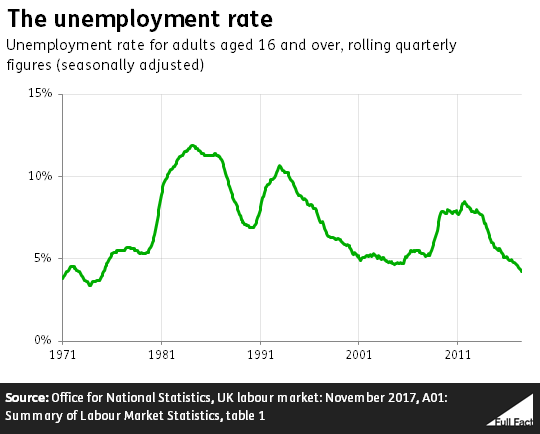What was claimed
Unemployment is the lowest it has been since 1975.
Our verdict
This is correct looking at unemployed people as a percentage of all adults either working or looking for a job across the UK.
What was claimed
Unemployment is the lowest it has been since 1975.
Our verdict
This is correct looking at unemployed people as a percentage of all adults either working or looking for a job across the UK.
“The employment figures were excellent this week. The lowest unemployment since 1975.”
Nadhim Zahawi MP, 16 November 2017
There were 1.42 million adults unemployed in the UK in the summer of 2017. That’s 4.3% of people aged 16 or over classed as economically active—those either in work or looking for work.
It’s correct that the last time the unemployment rate was this low was in 1975.

The unemployment rate varies for different groups of people. For example, the unemployment rate for men is the same as the UK-wide total—4.3% and the lowest since 1975. For women it’s even lower, 4.2% and the joint-lowest it has been since records began in 1971.
11.9% of 16 to 24 year olds (either in work or looking for it) were unemployed during the same period. That figure includes full-time students looking for part-time work. It’s also the lowest it has been since 2004.
Join 72,953 people who trust us to check the facts
Sign up to get weekly updates on politics, immigration, health and more.
Subscribe to weekly email newsletters from Full Fact for updates on politics, immigration, health and more. Our fact checks are free to read but not to produce, so you will also get occasional emails about fundraising and other ways you can help. You can unsubscribe at any time. For more information about how we use your data see our Privacy Policy.
Unemployment measures people without a job who have been actively seeking work within the last four weeks and are available to start work within the next two weeks, or who have found a job and are waiting to start in the next two weeks.
These figures don’t tell us anything about “underemployment”. That’s the number of people seeking more hours, working no more than the maximum weekly working hours already, and able to work more within the next two weeks. We’ve written about this before here.
Full Fact fights for good, reliable information in the media, online, and in politics.
Bad information ruins lives. It promotes hate, damages people’s health, and hurts democracy. You deserve better.
Subscribe to weekly email newsletters from Full Fact for updates on politics, immigration, health and more. Our fact checks are free to read but not to produce, so you will also get occasional emails about fundraising and other ways you can help. You can unsubscribe at any time. For more information about how we use your data see our Privacy Policy.